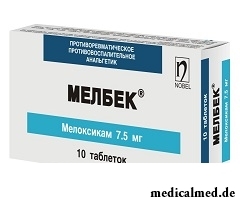





Melbek
Application instruction:
 Melbek – the non-steroidal anti-inflammatory drug used for symptomatic therapy of degenerative and inflammatory diseases of joints which are followed by a pain syndrome.
Melbek – the non-steroidal anti-inflammatory drug used for symptomatic therapy of degenerative and inflammatory diseases of joints which are followed by a pain syndrome.
Form of release and structure
Melbek is issued in two dosage forms:
- Solution for intramuscular introduction: chartreuse color, transparent (on 1,5 ml in ampoules, on 3 ampoules in pallets, on 1 pallet in a cardboard pack);
- Tablets: light yellow color, round, with risky on one of the parties (on 5, 10, 30 pieces in blister strip packagings, on 1-3 packagings in a cardboard pack).
Is a part of 1 ampoule (1,5 ml) of injection solution:
- Active ingredient: to meloksika – 15 mg;
- Auxiliary components: 1 M solution of sodium hydroxide or 1 M Acidum hydrochloricum solution, glycine, меглумин, half-oxameasures 188, гликофурол, sodium chloride, water for injections.
Is a part of 1 tablet:
- Active ingredient: to meloksika – 7,5 mg;
- Auxiliary components: microcrystallic cellulose, sodium citrate, colloid silicon dioxide, кросповидон, lactose, magnesium stearate, povidon-KZO.
Indications to use
Melbek is appointed for symptomatic therapy of an osteoarthrosis, a pseudorheumatism, Bekhterev's disease (an ankylosing spondylarthritis), and also other inflammatory and degenerative diseases of joints with a pain syndrome.
Contraindications
Absolute:
- Dekompensirovanny heart failure;
- Diseases of intestines of inflammatory character (disease Krone, nonspecific ulcer colitis);
- Bleedings (including cerebrovascular);
- The expressed liver failure or active diseases of a liver;
- The expressed renal failure at the patients who are not exposed to dialysis (the clearance of creatinine is less than 30 ml in a minute), the progressing diseases of kidneys, including the confirmed hyperpotassemia;
- The period after performing aortocoronary shunting;
- Combination (partial or full) bronchial asthma, the nose recuring a polypose and okolonosovy bosoms with intolerance of acetylsalicylic acid and other non-steroidal anti-inflammatory drugs (including instructions in the anamnesis);
- Erosive and ulcer changes of a mucous membrane of a stomach or duodenum, active gastrointestinal bleedings;
- Rare hereditary diseases: a lactose intolerance, deficit of lactase or glyukozo-galaktozny malabsorption (for tablets);
- Intolerance of acetylsalicylic acid and medicines of a pyrazolon row (for tablets);
- Pregnancy;
- Breastfeeding (lactation period);
- Age up to 18 years (for injection solution); up to 15 years (for tablets);
- Hypersensitivity to drug components.
Relative (Melbek it is necessary to apply with care at the following diseases / states):
- The brain diseases caused by pathological changes of cerebral vessels, which are followed by disturbance of cerebral circulation (cerebrovascular diseases);
- Diabetes mellitus;
- Coronary heart disease;
- Lipidemia and/or dislipidemiya;
- Diseases of peripheral arteries;
- Chronic heart failure;
- Somatopathies (at a heavy current);
- Clearance of creatinine of 30-60 ml a minute;
- Digestive tract cankers in the anamnesis;
- Helicobacter pylori infection (Helikobakter of a pilora);
- Frequent use of alcoholic beverages, smoking;
- Long therapy by non-steroidal anti-inflammatory drugs;
- Simultaneous use with selective serotonin reuptake inhibitors, antiagregant, peroral glucocorticosteroids, anticoagulants;
- Advanced age.
From digestive tract it is necessary to apply the smallest effective doses to decrease in risk of emergence of disturbances by minimum possible courses.
Route of administration and dosage
Solution for intramuscular introduction:
The drug should be administered by means of a deep intramuscular injection (intravenous administration of solution is contraindicated).
Melbek in the form of injection solution it is necessary to apply only for the first 2-3 days of therapy then to pass to administration of drug inside. The daily dose is defined by weight of inflammatory process and intensity of pains and can make 7,5 or 15 mg, frequency rate of use – once a day.
It is impossible to mix in one syringe solution with other medicines.
Tablets:
Melbek in tablets accept inside, it is more preferable – during food.
Drug is usually appointed in the following daily doses (in 1 reception):
- Ankylosing spondylarthritis – 15 mg;
- Pseudorheumatism – 15 mg (at improvement the dose can be reduced twice);
- Osteoarthrosis – 7,5 mg (in case of insufficiency of effect it is possible to increase a dose to 15 mg).
The maximum daily dose of Melbek (tablets or injection solution) makes 15 mg. With the increased risk of development of side effects, and also at the patients who are on a hemodialysis with the expressed renal failure it is not necessary to use drug in a daily dose more than 7,5 mg.
Totally the dose of Melbek applied in the form of tablets and injection solution should not exceed 15 mg a day.
Side effects
- Nervous system: often – a headache, dizziness; infrequently – drowsiness, a sonitus, вертиго; seldom – nightmares, a disorientation, emotional lability, confusion of consciousness;
- Cardiovascular system: often – peripheral hypostases; infrequently – heartbeat, increase in arterial pressure, "inflows" of blood to face skin;
- Alimentary system: often – dyspepsia (including nausea, vomiting, diarrhea, abdominal pains, a lock, a meteorism); infrequently – a gastroduodenal ulcer, an eructation, a hyperbilirubinemia, passing increase in activity of hepatic transaminases, an esophagitis, stomatitis, bleeding from digestive tract (including hidden); seldom – hepatitis, perforation of digestive tract, colitis, gastritis;
- Urinary system: infrequently – a hyperpotassemia, a giperkreatininemiya and/or increase in urea in blood serum; very seldom – an acute renal failure; connection with performing therapy is not established – intersticial nephrite, an albuminuria, a hamaturia;
- Respiratory system: seldom – acute development of bronchial asthma, a bronchospasm;
- Bodies of a hemopoiesis: infrequently – anemia; seldom – change of a blood count (including thrombocytopenia, a leukopenia);
- Sense bodys: infrequently – вертиго; seldom – vision disorders (including a sight illegibility, conjunctivitis), a sonitus;
- Integuments: infrequently – an itch, a Quincke's disease, skin rash; seldom – a small tortoiseshell, a toxic epidermal necrolysis, Stephens-Johnson's syndrome; very seldom – violent rashes, a multiformny erythema;
- Allergic reactions: infrequently – anaphylactic/anaphylactoid reactions;
- Local reactions (at use of injection solution): burning and pain in an injection site.
Special instructions
It is necessary to be careful when performing therapy at patients with existence in the anamnesis of instructions on a peptic ulcer of a stomach and duodenum, and also at the patients applying anticoagulants (because of the increased risk of emergence of erosive peptic ulcers of digestive tract).
Correction of the mode of dosing at a renal failure with clearance of creatinine more than 30 ml a minute is not required.
At combined use of Melbek with diuretic drugs it is necessary to accept enough liquid.
In case of the allergic reactions which are shown in the form of skin rash, an itch, a photosensitization or a small tortoiseshell, treatment needs to be stopped.
It is necessary to consider that Melbek can mask symptoms of infectious diseases. Also drug influences fertility in this connection it is not recommended to be applied to women who plan pregnancy.
During therapy such undesirable effects as dizziness, a headache and drowsiness therefore during this period it is recommended to refuse control of motor transport and performance of work which demand from patients of the increased concentration of attention can develop.
Medicinal interaction
At combined use of Melbek with some drugs the following effects can develop:
- Other non-steroidal anti-inflammatory drugs (including acetylsalicylic acid): increase in risk of developing of bleedings of digestive tract and erosive cankers;
- Hypotensive medicines: decrease in their efficiency;
- Thrombolytic drugs, anticoagulants: increase in risk of developing of bleedings (it is required to control periodically indicators of coagulability of blood);
- Methotrexate: increase in risk of development of anemia and a leukopenia because of strengthening of its side effects on system of a hemopoiesis (it is required to control periodically the general blood test);
- Selective serotonin reuptake inhibitors: increase in risk of developing of gastrointestinal bleedings;
- Intrauterine contraceptive means: decrease in their efficiency;
- Lithium drugs: cumulation of lithium and increase in its toxic influence (at joint appointment it is recommended to control concentration of lithium in blood);
- Cyclosporine and diuretics: increase in risk of developing of a renal failure;
- Colestyraminum: strengthening of its removal from digestive tract.
Terms and storage conditions
To store in protected from light, the place, dry, unavailable to children, at a temperature up to 25 °C.
Period of validity – 4 years.
The 74-year-old resident of Australia James Harrison became blood donor about 1000 times. It has a rare blood group which antibodies help to survive the newborn with a severe form of anemia. Thus, the Australian saved about two million children.

Work of a brain is extremely complex and in many respects is not studied yet. It is confirmed also by the features of thought processes which are shown in...
Section: Articles about health
Bathing in broths of medical flowers and plants (phytobathtub) was eurysynusic since Cleopatra who is a good judge in all that concerns beauty and health. And today phytobathtubs is the simple and available means allowing not only to remove nervous N...
Section: Articles about health
For anybody not a secret that our country is one of the most "drinking" in the world. At clear understanding that the use of hard alcoholic drinks – occupation extremely harmful, most of Russians belong to alcoholism with unjustified loyalty. Apparently, existence of a set of myths in which tendency to excessive libations looks nearly positively is explained by it. It is worth getting acquainted with the most widespread of similar delusions and to be convinced in them not...
Section: Articles about health
It is impossible to imagine human life in which there would be no plants. Practically in each apartment and any of productions...
Section: Articles about health
For most of the working people the problem of having a snack is particularly acute enough. Sooner or later there is a question: what can be eaten quickly between a breakfast and a lunch or a lunch and leaving from service so that to receive necessary power feed, but not an overload...
Section: Articles about health
Mushrooms - the surprising inhabitants of our planet having a set of wonderful qualities. Thanks to one of them, a mold mushroom of Penicillium notatum, the first natural antibiotic - penicillin was received nearly 80 years ago. The mankind is obliged to this opening by millions of saved lives....
Section: Articles about health
Residents of big cities quite often have a disease which is known as the syndrome of chronic fatigue (SCF) today. This illness...
Section: Articles about health
Striya (extension) are the defects of skin having an appearance of direct or wavy strips from 1 to 10 cm long and 1-5 mm wide. In most cases at women of a striya are located on a stomach, hips, a breast or buttocks. At athletes they can appear on shoulders and внутренн...
Section: Articles about health
Life does not indulge the modern woman special emotional comfort and carelessness. The fatigue, troubles at work, misunderstanding in a family and various illnesses immediately affect a condition of hair and skin. And there is a wish to look safe and attractive so! Substantially competently picked up diet can improve situation....
Section: Articles about health
Bees – really unique beings. Practically all products of their life activity are used by the person. Since the most ancient times from...
Section: Articles about health
Reactive pancreatitis - the disease which is characterized by inflammatory process in a pancreas which arises most often because of excess activity of digestive enzymes. It − the emergency state which treatment has to take place in хирургич...
Section: Articles about health
Energy saving lamps are one of the most popular products of innovative technologies, and there is no wonder: they much more economic also are more long-lasting than usual filament lamps. At the same time there are fears that energy saving bulbs can become the reason of emergence of problems with health. Unfortunately, some of similar opinions have the real reasons....
Section: Articles about health
The technique of acupuncture (acupuncture) is used in the medical purposes more than three and a half millennia. It widely races...
Section: Articles about health
There is a lot of fans of beer in our country. Statistically, on each average Russian (including women and children) in a year about 60 liters of this drink are consumed. It is not a lot of, as in the Czech Republic or Germany, but figure all the same impressive. Radova...
Section: Articles about health
All are familiar with cold, and practically everyone believes that he has sufficient knowledge and experience that correctly to treat it. In practice most of people makes mistakes in attempts to get rid of rhinitis, and divides numerous delusions it....
Section: Articles about health
Practice of use of table salt in the therapeutic purposes contains not one century. Appl are considered especially effective...
Section: Articles about health
What woman does not dream of a beautiful and thick hair? While physicians developed difficult schemes on hair transplant, in the industry of hairdresser's art a few years ago there was a sensation – methods of hair extension appeared. It would seem, dreams came true...
Section: Articles about health
Feeding by a breast - the integral part of ideal motherhood allowing to come into contact with the kid and to create to it healthy immunity since early years. Nevertheless, this important process in life of mother and child can be saddened laktostazy − by a milk delay in a mammary gland. What main reasons for a laktostaz? How not to allow problems with breastfeeding? Let's consider 10 premises resulting in stagnation of milk at the nursing mother....
Section: Articles about health
The pine is one of the most widespread plants of our woods. Its needles and pitch not without reason called by "gallipot", since ancient times испол...
Section: Articles about health
Statistically, at the address to doctors seven of each ten patients complain of a headache. Actually it is much more people who are periodically feeling unpleasant feelings such. Many people, apart from a headache the reason for serious fear...
Section: Articles about health
The fatigue, sleep debt, disturbances of food, bad mood, vagaries of the weather – all these circumstances badly affect our appearance. Especially the person suffers: skin becomes flabby, loses healthy color, becomes covered by wrinkles, zones of hypostases and dark circles under eyes appear. It is not always possible to be saved from influence of aggressive factors, but we are quite able to minimize its effects. For this purpose usually apply the cosmetics and procedures helping увлаж...
Section: Articles about health
Each person knows that fervescence is an illness sign. However about existence of diseases can to suite...
Section: Articles about health
The business lady, the become mother, it is necessary to solve an array of problems. But of them is main: how to combine the beloved child and work? What traps trap the working mother and how she needs to behave?...
Section: Slideshow
Partial and the more so full loss of hearing significantly reduces quality of life. Difficulties with communication lead to loneliness and isolation. The person who badly hears experiences difficulties with social and professional implementation, quite often has problems in private life....
Section: Articles about health
The hysteromyoma is diagnosed more than at a third of women 35 years are more senior. This high-quality new growth, which on early a stage...
Section: Articles about health
The metabolism at each person proceeds in own way. However between the speed of this process and disposal of excess weight after all all have a dependence. Unfortunately, the people inclined to try on itself numerous "miracle" diets, not always at...
Section: Articles about health
Extracorporal fertilization – one of the most modern methods of controlling with infertility. So far he already helped a significant amount of married couples to become happy parents. Usually to the EKO procedure difficult and very expensive, resort in those situations when all other ways to help couple to bring the child are inefficient. "Conception in a test tube" yields quite good results in cases of infertility of one of partners, existence at the woman of impassability of uterine tubes...
Section: Articles about health
